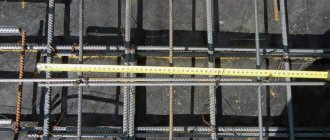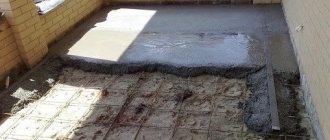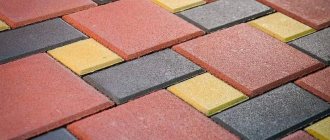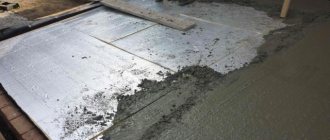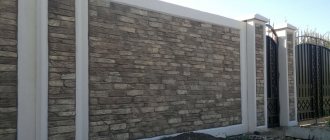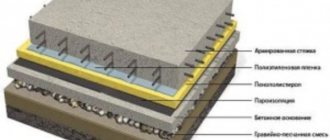During construction, situations arise when it is necessary to cut the material for its further use for its intended purpose.
At first glance, it seems that cutting a concrete block is easy, but it is not. Compared to foam concrete, aerated concrete and other porous and light-weight materials, the concrete block is very strong and rarely lends itself to easy sawing.
Before making a cut, it is recommended that you familiarize yourself with the best way to do it.
When might cutting or sawing be required?
Concrete blocks come in standard sizes and the building materials market rarely focuses on selling anything non-standard.
During the construction process, the master understands that he needs to find a block that could complete the masonry in a certain place, and standard material will not work here. In such a situation, you have to resort to cutting the block concrete material.
If concrete blocks of non-standard size are needed in large quantities, then it is better to cast them yourself using homemade molds. You can also order non-standard blocks from the manufacturer, but this will cost more.
Often, a builder may need half or a quarter of a whole concrete block. Then you need to make a cut.
Similar situations often occur when pouring a strip foundation, when all the blocks must be the same size, and when completing its arrangement, several elements are missing. The same situation can arise when constructing a building according to an established design, when the thickness of the walls is already clearly defined and it is impossible to deviate from the values.
Often, when laying corners, it is not possible to fit the concrete block correctly and gaps remain between the stones. Many builders fill them with fragments of material, which is also not entirely true. In this case, it is recommended to pay attention to the tools and methods by which you can quickly and easily cut concrete block material.
Cinder Block Laying Tools
Back to top
In the image:
tools necessary for laying a stone wall, 1 - trowel (trowel), 2 - mortar shovel, 3 - jointing for convex and concave seams, 4 - hammer-pick, 5 - plumb line, 6 - square, 7 - building level, 8 - tape measure , 9 - level, 10 - folding meter, 11 - duralumin rule, 12 - order.
1. A trowel is a steel shovel with a wooden handle, which is used to level the mortar, fill the seams, and trim off excess mortar.
2. The mortar shovel is designed to mix the mortar without allowing it to separate, apply it to the wall and spread it.
3. Joints with which the seams can be given a convex, concave, triangular, rectangular recessed shape.
4. A pick hammer is used when chopping and hewing bricks or blocks.
5. A plumb line, with its help the mason controls the verticality of the wall, piers, corners, and so on. This tool, depending on whether the verticality of the masonry is checked within one or several floors, has a different weight. For the first case it is 200 - 400 g, for the second 600 - 1000 g.
6. The square is used to check angles.
7. Construction level, which is designed to control the horizontal and vertical plane. Available in lengths of 300, 500 and 700 mm. Structurally, it consists of an aluminum case with two glass ampoules filled with non-freezing liquid, in which an air bubble remains. The principle of operation of the device is simple: place it on the surface of the wall and look at the position of the bubble. If it measures in the middle between the divisions of the ampoule, then the surface is horizontal; if it is shifted in any direction, then there is a deviation.
8. Tape measures and folding meter are designed for measuring short distances.
9. Rules-level - this tool is made from trimmed wooden (section 30 × 80 mm, length 1.5 - 2 meters) or duralumin slats with a special profile. With its help, the front surface of the laid wall is controlled.
10. Ordering - is a wooden strip (section 50 × 50 or 70 × 50, length 1.8 - 2 meters) with divisions every 77 mm, which is equal to the thickness of one row with a solution (65 mm + 12 mm). The order can also be made from a metal corner, on the edges of which divisions with a depth of 3 mm and a pitch of 77 mm are cut.
How and what is the best way to cut - the main methods
At the moment, through experimental experiments, several methods of cutting concrete blocks have been established. This includes the manual method, where you can use a grinder, wedges, cotter pins, as well as a method in which specialized equipment is used. Each method requires detailed consideration.
Manual method
The use of a manual cutting method presupposes the absence of automated equipment; the craftsman will have to cut the block with his own hands.
For this it is good to use:
- grinder;
- wedges or cotter pins, splitting the material.
It is impossible to break or split even the lightest concrete block by hand. The material has a good margin of safety, so it is impossible to do without the use of auxiliary tools.
The manual method is chosen when access of special equipment to the site is impossible due to obstacles . Also, this technique is suitable if it is necessary to saw a small amount of block material and calling a team of workers with equipment is costly and does not make sense.
Cutting with a grinder
The first and most relevant method is working with an angle grinder.
It is known that using this tool you can easily cut foam concrete, aerated concrete and other lightweight materials. But can a grinder handle a concrete block? To do this, you need to choose a powerful power tool - it must be in full working order.
Before starting work, it is recommended to take care of personal protective equipment.
It is worth purchasing a gas mask or respirator in advance; you can use construction gloves. The use of glasses will be a must: fine dust from the concrete will fly in all directions and can get into your eyes.
You need to choose a good cutting disc for an angle grinder . Since concrete is considered a durable material, it is difficult to work with. It is better to use a diamond blade for cutting. They are segmented, continuous and combined.
A segmented one is not suitable for such a durable material, but a solid one heats up when cut and should be watered with water. To cut a concrete block, it is better to purchase a combined diamond blade.
It is important to find out whether the concrete block has reinforced rods. If the disk cutter comes across them during operation, a failure may occur. Therefore, it is better to choose turbocharged wheels if the block thickness is more than 10 cm.
When all the tools are ready, you can start working:
- Marking . Before making a cut, you need to mark the line where the cut will take place. It is better to do this with a contrasting marker, so that even with glasses the artist can see the line. To make the line perfectly straight, you can place a wooden block along it.
- Incision. After turning on the grinder, it is necessary to make an incision 0.5-1 cm deep.
- Sawing . After this, the block is removed and the cutting disc begins to be drawn deeper. Until it is completely possible to cut the concrete block. If the tool gets very hot, you need to stop and take breaks for several minutes. Most likely, the cutting disc will also heat up: you can periodically water it with cold water in a thin stream.
The advantage of this method is speed and minimum effort, as well as the ability to cut even those blocks that have metal reinforcement inside.
Splitting with wedges
cut a foundation or wall block made of concrete using wedge splitting.
This method allows you not to hire specialized equipment and do it yourself, while saving money.
But there are also disadvantages - the method is less accurate, and if the technology is not followed, the block may split diagonally.
In this case, the concrete block will become unsuitable for the master’s purposes and other raw materials will have to be used.
To split with wedges you need to prepare:
- a hammer drill with a drill whose length is slightly less than the thickness of the block;
- metal wedges;
- sledgehammer;
- marker for marking.
At the first stage, builders make markings, and they must be done along all edges of the building block, regardless of its thickness. The markings must be clear, so it is best to use a ruler or a special long square.
Next, the hammer drill gets down to business: using this electric tool, you need to drill 7-10 holes along the marked line. You can mark only on the side that is accessible; if possible, you can mark all sides.
When holes 7 cm deep are drilled, metal wedges are inserted into them. When purchasing wedges, it is worth considering that their end must be sharp. When the wedges are inserted, you need to hammer them in a little using a sledgehammer.
As a result of impacts, a crack forms along the entire length of the marked line. If everything is done according to technology, the crack will be even. The concrete block is split into 2 parts. At the final stage of work, builders use a sledgehammer and a saw to level the block so that it can be used for its intended purpose.
One of the disadvantages of this method is the duration of the procedure. Not every time you will be able to get a perfectly even crack.
Splitting with cotter pins
Cotter pins are special pegs made of wood or metal. Wooden cotter pins must be used to split the concrete block. This method works on the principle that the material expands when it gets wet. To split a block you will need a hammer drill with a drill, a marker for marking, wooden cotter pins with a thin tip, and a sledgehammer.
The work looks like this:
- Markings are made on three sides of the concrete block.
- Using a hammer drill, drill about 7-10 holes.
- Wooden cotter pins are inserted into the holes.
- The cotter pins are watered with water.
- When the cotter pin picks up moisture, it begins to get wet and swell. As a result, the tree expands and presses on the concrete block from the inside.
- The body of the block will be split in half.
Then, using a sledgehammer and a saw, you can adjust the evenness of the surface of the block. The peculiarity of this method is that it is necessary to drill holes exactly to the diameter of the cotter pin, no more.
The downside is the long wait time for the result, but there are also advantages: this method is more gentle than using wedges, since the likelihood of diagonal splitting is minimized.
Use of special equipment
The use of specialized equipment is necessary when it is impossible to lift the block yourself. This is relevant when working with foundation blocks of great length and weight. First, you need to order the services of a crane that can lift the block to a height.
To do this, the block must have “ears” made of metal.
You also need to prepare:
- angle grinder with a diamond disc;
- marker for basting;
- ruler - square.
It's better to work with a partner:
- The concrete block is placed on a flat surface, which will be used as a substrate.
- Using a ruler-square and a marker, make a mark in the place where it is necessary to split the block.
- Using a grinder with a diamond blade, cuts are made to a depth of 5-7 cm along the entire perimeter of the block - along 3 accessible sides.
- The crane then hooks a hook behind one of the “ears” on the block and begins to lift it. Often a height of several meters is enough.
- The crane sharply loosens the tension of the cable and the block is pushed back onto the surface, splitting in the process.
This method allows you to get an almost even split of the concrete block; you can use a saw and hammer to finish the surface. The technique is quite fast and simple and is suitable for large-scale construction.
Electric jigsaw
Craftsmen know this type of jigsaw as a reciprocating saw. This saw is used in the construction of medium and large objects.
You can change the blades on a jigsaw (put discs with different tooth sizes, change dull or damaged discs; the shape of the teeth on the discs can also be different - large and small teeth).
As a rule, for the convenience of builders, many saw models are available with replaceable batteries so as not to be tied to a power source.
When working with this type of tool, you must remember that sawing wet material is not permissible, as this may result in injury. The saw will “chew” the crumbs and may injure the builder.
Before starting work, it is better to try on the tool. Play through the saw movements without the power on.
You need to cut with the middle part of the saw; the length of the working cutting surface should be approximately 25 centimeters.
To avoid injury, you should hold the saw firmly in your hands.
Alligator
The alligator-type saw is particularly durable and wear-resistant. The teeth of such a saw have special coatings made of pobedite, which makes the teeth more durable. This tool is used in the construction of large objects (apartment buildings, large offices).
The advantage of this tool is that it does not need to be constantly sharpened or blades changed, as, for example, in an electric jigsaw.
When purchasing such a saw, it is better to choose an option with a thick-walled blade, since only cutting with such a blade will give an even cut without chips or roughness.
It is often written that before starting to work with such a saw, you need to lubricate the surface with a special lubricant, but practice says otherwise. The lubricant mixes with dust, causing the saw to stop working.
Although the instructions for most tools of this type specify the use of lubricant. The absence of lubricant increases productivity significantly.
Using an acidic mixture
Experts know how to destroy concrete without physical effort, and what substance has a detrimental effect on it. Based on this, an acid mixture, which is a material, is often used to dismantle durable reinforced concrete structures.
To remove a small amount of a hard substance from the surface, it is enough to apply a substance on top of it, for example, hydrochloric acid.
In most cases, acid is used very rarely in its pure form; a special mixture is prepared for this purpose.
With its help you can:
- dissolve concrete;
- remove it from bricks;
- wash off the residue from the wall.
The mixture contains concentrated acids and inhibitors. The latter are needed to protect other surfaces when processing concrete. For example, if you need to clean a frozen concrete mixer. The mixture will quickly penetrate deep into the material and destroy it; as a result, after some time it will turn into dust, which can be easily swept away with a simple brush.
How to split a foundation block manually
Question:
Nikolay from Tver asks: “Hello! Please tell me what simple methods exist for splitting foundation blocks at a construction site?”
Answer:
Hello Nikolay. There are many ways, first I’ll tell you how to split a block using a crane, and then several ways to cut a block by hand.
Using special equipment
On a construction site, it is usually necessary to cut the block to fill gaps between corners and service openings. Slotting with a hammer drill is strictly prohibited, since with numerous impacts, numerous cracks open inside the concrete, reducing the bearing capacity of the foundation.
According to existing standards SP 22.13330 (Building foundations), SP 50-101 (Design of foundations/foundations) and standard PPR work plans, exclusively solid FBS should be used in prefabricated strip foundations. The designer must prepare a layout diagram taking into account the dimensions of reinforced concrete products, according to GOST 13579. In practice, the need to split the block arises in 99%.
Currently, there are no power tools or accessories for them that allow sawing a foundation block in one step and even along the ring (a cut on each of the 4 sides). Therefore, the following FBS cutting technology is more often used:
- the block is installed on a rigid base (another FBS laid on its side or a hollow-core road slab) using the standard slinging method using two mounting loops;
Preparation for cutting FBS.
- then the block is hooked with one loop and lifted by a crane by 5 - 10 cm;
- use a tape measure to mark the required length of a piece of FBS on the body of the concrete product;
- in this place, rolled metal is placed under the sole of the element being split (a corner with the edge up or steel scrap);
Installation of scrap under the foundation block.
- the sling is wound as close as possible to the edge of the FBS on the short side;
Slinging the block for splitting.
- when rising to a certain height, the sling breaks off from the body of the block, which falls from a small height and splits along the intended line.
Broken foundation block.
The problem with high-quality blocks is that they split diagonally with unpredictable results. That's why professionals sacrifice time to ensure cutting accuracy:
- quick option - use a sledgehammer to knock down the accessible edges in the areas where the side surfaces meet (usually the top two);
Bevel corners FBS.
- qualitative method - an angle grinder with a diamond disk creates cuts to the entire depth of the equipment on three accessible surfaces of the FBS.
Grinder cuts for precise splitting.
After which, the FBS is guaranteed to break off along a line perpendicular to its long part.
Without special equipment
Even the lightest FBS block cannot be assembled manually, so the owner of the property under construction has to rent a crane. Therefore, the time spent by special equipment on site is critical; all possible operations are performed manually in order to reduce the construction budget. Therefore, two “folk” technologies are often used: splitting with a wedge or wooden cotter pins.
They allow you to prepare pieces of the required length without a crane, but you must first place the blocks for splitting on a hard surface. The wedge splitting method looks like this:
- 7 - 10 blind holes of arbitrary diameter are created along the cutting line to a depth of 5 - 7 cm;
- they simultaneously install wedges sharpened from scraps of rolled metal;
- by alternately immersing all the wedges, a single crack is created along the cutting line and the concrete product splits into two pieces.
Folk technology for splitting concrete beams with wedges.
Another option takes more time, so it is used less often:
- holes are made on three accessible faces (top and two sides), but with a diameter of 10 - 20 mm;
- wooden cotter pins are driven into them from a dry board;
- then they are generously moistened with water to expand the wood, which splits the FBS.
In construction stores you can find (very rarely) a non-explosive mixture with the ability to self-expand NRS-1M. It is poured into blind holes, after which it becomes an improvised wedge, splitting not only concrete, but also any type of natural stone, for which this substance was invented.
At the site of the chip there were traces from the holes into which NRS-1M liquid was poured.
Important! The last two methods make it easier to cut several pieces from one FBS. However, you will have to pick them up for installation with a special grip, which not every crane operator has.
Thus, one FBS can be divided into pieces of the required length in several ways. The choice depends on the construction budget, the number of auxiliary workers and weather factors.
Advice! If you need builders to build a foundation, there is a very convenient service for selecting specialists from PROFI.RU.
Just fill out the order details, the experts will respond and you can choose who to collaborate with. Each specialist in the system has a rating, reviews and examples of work, which will help with the choice. Looks like a mini tender.
Placing an application is FREE and does not oblige you to anything. Works in almost all cities of Russia.
If you are a master, follow this link, register in the system and be able to accept orders.
How to break a concrete block - various options
During construction work, it becomes necessary to break down a structure made of concrete, which is a strong material, that has served all its terms. Its main purpose is to support the entire structure. For this reason, the question is often asked - how to break a concrete block. And there are several ways to do this.
Block design
For the manufacture of such elements, different types of concrete material are used:
- heavy, the density of which is from 1,800 kg per cubic meter;
- lung (no more than 1,200);
- dense on a silicate basis (within 1,800).
Wall block elements used for arranging basements are divided into several groups:
- solid;
- block elements with cutouts for pipes and lintels near the basement ceiling, in the walls or above the floor surface;
- void elements. Four areas of voids throughout the block, with an open bottom.
Methods of destruction
To know how to destroy a concrete block with your own hands, study the methods that exist for this.
We use a sledgehammer
This is an easy way to destroy small structures using a sledgehammer. The speed of work in such a situation will depend only on the physical characteristics of the person. If they are small, then you will need to spend time and effort on this work.
To reduce the strength of concrete, the element is drilled in certain places with a hammer drill. After this, breaking the block becomes much easier.
It is commonly believed that you can use a sledgehammer to break a reinforced concrete slab. Is it necessary to waste energy when there are other, easier options?
We use powder
How to split a concrete block with your own hands using powder?
Frequently asked questions and answers
Today, cadastral work and its result is a document that is an electronic form of an approved form (Xml schema). Any result of cadastral work can be signed with an electronic digital signature (EDS) of the applicant, which will allow the copyright holder not to waste time visiting the MFC to transfer a package of documents for cadastral registration or registration of rights to a property, but to send an electronic document via the Internet to Rosreestr. To produce an electronic signature, you must contact any certification center that produces qualified certificates of electronic signature verification keys (KSKP EP), in accordance with the Federal Law of 04/06/2011 No. 63-FZ “On Electronic Signatures” for Rosreestr. When producing KSKP ES for individuals and legal entities, a special information encryption algorithm is used, which excludes changes to the document signed with such an electronic signature.
The procedure for approving the boundaries of a land plot is established by 221-FZ of July 24, 2007. and is mandatory if cadastral work is carried out, as a result of which the location of the border(s) of the land plot in respect of which the work was carried out, or adjacent land plots, information about which is included in the Unified State Register of Real Estate, is clarified:
1) property; 2) lifelong inheritable ownership; 3) permanent (indefinite) use; 4) lease (if such adjacent land plots are in state or municipal ownership and the corresponding lease agreement is concluded for a period of more than five The procedure for approving boundaries includes: 1) Notifying all interested parties; 2) carrying out coordination of boundaries and drawing up an approval act. Notification of rights holders of adjacent land plots can be carried out either individually or by holding a meeting to agree on the location of boundaries and by publishing in the media in the manner established for the official publication of municipal legal acts. The publication of a notice of border coordination is carried out in the absence of information in the Unified State Register of Real Estate about the contact addresses of interested parties. You can read more in detail in this article at the link.
From 01/01/2017 there was a merger of procedures for cadastral registration and registration of rights to real estate in accordance with the Federal Law No. 218 of July 13, 2015, which came into force. “On state registration of real estate.” It will now be possible to register a property in one stage by the copyright holder submitting a package of documents to the authorized federal bodies to carry out a set of procedures and, as a result, receive an extract from the Unified State Register of Rights about the registered right. To date, this procedure, unfortunately, has not been technically implemented by Rosreestr, but according to information provided by the Ministry of Economic Development, the possibility of carrying out simultaneous cadastral registration and registration of rights is planned for 07/01/2017.
In the case of the formation of a land plot from lands in state or municipal ownership, in accordance with the Land Code, the plot is provided on the basis of the layout of the land plot on the cadastral plan of the territory. The layout diagram for the KPT has an approved form in accordance with the orders of the Ministry of Economic Development and can be prepared both electronically and in paper form. The electronic form is an Xml schema format and is signed with the electronic signature of the authorized local government body. The provision of a land plot based on the layout of the KPT is carried out for plots provided for gardening, personal farming, and individual housing construction.
The inability to read a disk certified by the electronic signature of a cadastral engineer on the device of the MFC or the Rosreestr registrar is one of the reasons for the suspension of cadastral registration. However, the problem is often not a defect in the disk or reading device, but in other nuances, which are reflected in more detail here. To solve this problem, you should contact the cadastral engineer who prepared the package of documents again, and he will rewrite the disk for you.
Chemicals
Chemicals that allow the dismantling of concrete structures include:
- Mixtures with high acidity, which dissolve concrete in a limited time, violate its integrity and provide the ability to remove bricks and concrete residues. The basis of acid compositions is concentrated hydrochloric acid and special inhibitors that penetrate deeply into the massif, expanding it. The use of acidic compounds requires the mandatory use of protective equipment for operating personnel.
- Special-purpose powders with an increased expansion coefficient, which are used to fill pre-prepared holes. Implementation of the process requires significant financial costs, but allows you to achieve the required result within 24 hours, using a minimum amount of labor.
Chemicals are used to destroy durable building materials, since their use prevents fires and explosions
Similar topics
Columnar foundation - types, photos, videos
Compared to strip or slab foundation structures, a columnar foundation requires a much smaller investment. At the same time, in terms of reliability, a columnar foundation is practically not inferior to
Do-it-yourself slab foundation - design, photo, video
To build a small house, you can choose the simplest foundation design - a solid slab. These foundations are a type of shallow, or rather, non-buried foundations. Their depth ranges from 40 cm to 50 cm
Screw foundation: advantages, technology. Photo. Video.
Pile screw foundations are fairly new types of foundations that can significantly reduce the cost of equipment, building materials and labor costs.
Construction of a frame house: definition, design stage, advantages
A frame house is the most popular type of construction on a country site. The process of its construction does not require large investments, and anyone can successfully cope with it, subject to a number of rules.
DIY columnar wooden foundation
In this article we will take a closer look at a wooden columnar foundation. It is installed under bathhouses, as well as light yard buildings made of frames, logs, timber.
Do-it-yourself columnar foundation: materials, instructions | Bored pile foundation
Instructions for installing a columnar foundation with your own hands. Application of roofing felt formwork, PVC pipes, A/C pipes. Pillars with widening using TISE technology
Specifications
GOST, which regulates the production and technical characteristics of FBS, provides for blocks of the following sizes:
- length 2380, 1180, as well as additional length 880 mm,
- width 300, 400, 500 and 600 mm,
- height 280 or 580 mm.
By the way! It will be interesting to know: Calculation of the width and depth of a strip foundation: minimum thickness according to standards
FBS foundation blocks are made of heavy (density 2400 kg/cub.m), silicate (density 2000 kg/cub.m) or expanded clay (density 1800 kg/cub.m) concrete. The strength class of concrete should be
- not less than B7.5 for concrete grade M100,
- not less than B12.5 for concrete grade M150,
- for heavy concrete - from B3.5 (M50) to B15 (M200).
The table in the picture shows data on strength and weight for FBS made of different concrete.
Frost resistance of FBS must be at least 50 freeze-thaw cycles, water resistance - W2.
The type designation indicates its dimensions in decimeters, rounded up. The marking also indicates the type of concrete:
- "T" - heavy concrete,
- “P” - expanded clay (on porous fillers),
- "C" - silicate.
Let's give an example. FBS-24-4-6 t is a concrete block with dimensions of 2380*400*580 mm, consisting of heavy concrete. It can be marked in another way:
- 24-4-6 t,
- 24.4.6 t,
- 24 4 6 t.
The blocks have mounting steel loops (eyes) that are located on the top surface of the block. For hinges, hot-rolled reinforcement or periodic profiles are used. If necessary, you can order FBS without mounting loops; this is allowed by the standards.
Chemicals
Chemicals that allow the dismantling of concrete structures include:
- Mixtures with high acidity, which dissolve concrete in a limited time, violate its integrity and provide the ability to remove bricks and concrete residues. The basis of acid compositions is concentrated hydrochloric acid and special inhibitors that penetrate deeply into the massif, expanding it. The use of acidic compounds requires the mandatory use of protective equipment for operating personnel.
- Special-purpose powders with an increased expansion coefficient, which are used to fill pre-prepared holes. Implementation of the process requires significant financial costs, but allows you to achieve the required result within 24 hours, using a minimum amount of labor.
Chemicals are used to destroy durable building materials, since their use prevents fires and explosions
Add a comment
Without construction equipment, I divided FBS 24-6-3 into 8 equal parts for the base of a summer canopy. The block lay flat on the ground in the middle of the long side and dug a hole to insert a 2t rolling car jack under one rib (you need to put a board under the jack - otherwise it will sink into the ground). I jacked up one side, turning the block on the opposite edge of the long side. He placed wooden scraps, filled the hole, and again lifted it from the same place and turned it on a long edge with a jack even higher in 3 lifting shifts and turned it about 50 degrees.
Using a long pipe from below, according to the ARCHIMEDES principle, I managed to lift one - turn it 90 degrees and place it on the narrow side. I divided it vertically, first into 4 parts, then each in half. I drilled along the lines with a rotary hammer from 2 sides with a hammer drill Ф16 mm on each side half the thickness in increments of approximately 30 mm. I made a series of holes with a grinder and a diamond wheel, cut it to a depth of about 30 mm on three sides and connected the holes. I drove a chisel into the cut with a simple hammer from one edge - the block burst along the line of the holes.
Chemical means for destroying concrete
Of the chemicals used for these purposes, the special powder NRS-1 is most often used. With its help, the process of dismantling the old foundation can be completed in 1-2 days. To use it in concrete, you also need to drill holes first. Then an aqueous mixture is prepared: 0.27 liters of water are added per 1 kg of powder.
The powder and water are mixed for 10 minutes, then the drilled holes are filled to the brim with the resulting solution. Reacting with water, the powder expands its volume several times, breaking the concrete. But its use has temperature limits, below and above which it cannot be used: from +5 to + 30ºС.
To destroy concrete using NRS-1 it will take less than a day and a minimum of physical effort. The only but significant drawback is the high cost of the powder.
To destroy particularly strong concrete structures, you can resort to using a special acid mixture. This mixture actually dissolves the concrete, helping to clear it from bricks or remove excess from the wall.
Acid mixtures include concentrated acid, most often hydrochloric acid, and inhibitors. The latter are needed to protect other surfaces, such as brick or metal. The acid mixture penetrates deep into the concrete base and dissolves it, turning it into dust
But you need to use such mixtures very carefully, using maximum means for your own protection.
There are many ways to destroy concrete, because breaking is not building. The main thing is that this destruction occurs according to your desire, and is not caused by natural causes, provoking the destruction of the built house.
FBS foundation
Also, on weak soils, the first row is laid out not from ordinary FBS, but from special pillow blocks that have a larger width, thus increasing the area of the foundation base.
Gaps of no more than 70 cm are left between the blocks; they are filled with soil, carefully compacted in layers. Ordinary FBS are placed on a row of “pillows”, so that the seams between them fall on the blocks of the bottom row.
It is recommended to buy FBS as long as possible - this way there will be fewer seams in the foundation, therefore, it will be stronger. The video shows the process of building a foundation and basement from FBS.
Due to the strength of FBS, walls can be made thicker than the foundation. It is acceptable for the wall to protrude 10 cm on one side or 6 cm on each side.
Reasons for dismantling work and conditions for its implementation
Concrete structures are most often demolished when they have served their purpose or have begun to collapse due to man-made disasters or natural disasters. But there are other reasons why sometimes quite strong structures have to be destroyed.
- Clearing the area for new construction.
- Demolition of structures erected without a design or in violation of technology, and posing a danger.
- Work on redevelopment, reconstruction of buildings and communications.
- Dismantling old objects that do not fit into the landscape.
Since it is not always possible to gouge concrete without prolonged noise, strong vibration, dust and debris, dismantling work can cause serious inconvenience to people - residents of the house, neighbors. And when large objects are demolished, nature and nearby buildings suffer.
Demolition of a wall when remodeling a houseSource bosch-professional.com
To minimize these negative consequences and avoid conflicts, in each specific case you need to try to choose the optimal methods of destruction. They are mechanical, thermal, chemical. We will not consider explosives, since their use by private individuals is illegal.
Mechanical methods
Among the mechanical methods of destruction of concrete structures there are impact and non-impact. The first involves the use of tools such as a jackhammer, a hammer drill, or a regular hand sledgehammer.
Their use is inevitably associated with noise, dust, vibrations, and the risk of deformation of other objects. Therefore, it is better not to use impact methods in residential buildings.
In addition, such methods require great physical strength and endurance from the performer.
Impact tools will do an excellent job with tasks such as breaking the concrete of an old garden path, dismantling a blind area, or destroying part of the foundation. But you can’t do without them even in cases where you need to remove screed from the floor or cement plaster from the wall.
Cleaning walls from plaster with a hammer drillSource amazonaws.com
Modern tools and equipment allow you to perform concrete dismantling work with much less effort, without unnecessary noise and dirt.
Hydraulic wedges
A hydrowedge is a mounted or hand-held tool, the working part of which is two wedges. They are inserted into a pre-made hole in the concrete, after which a spreading force is created between them by hydraulics. When the wedges move apart, tension arises, forming a fault. After removing the broken debris, new holes are drilled.
Compact installations with hydrocline can be used even indoorsSource userapi.com
Hydraulic shears
Another name for this equipment is a concrete breaker. Like wedges, scissors do not create vibrations or dust and allow for fairly accurate dismantling of structures. At home and in cramped conditions, compact manual installations are used, and for the destruction of large objects, powerful attachments are used.
Hydraulic concrete demolition shearsSource dardauk.co.uk
Wooden wedges
This old “folk” method of destroying concrete at home is considered the most accessible and practically free. But it can only be used when the timing of dismantling work does not matter, since it takes a lot of time.
- In a concrete structure, you need to drill holes at a short distance from each other.
- Prepare hardwood wedges to fit the diameter of the holes and drive them in tightly.
- Ensure that wooden plugs are constantly wetted with water for up to 10-14 days.
When the wood is saturated with water, it will swell and tear the concrete.
Steel wedges
When there is no time to wait, they use impact splitting of concrete structures using steel wedges. They are inserted into drilled holes and driven deep with blows of a sledgehammer.
How to break concrete manually using steel wedges is shown in the video:
Thermal methods
Another budget method, the use of which does not require professional tools, is associated with alternating exposure of artificial stone to high and low temperatures. It cannot withstand their sudden change and begins to crack.
For heat treatment, you will need a blowtorch for heating and cold water for cooling. Due to the use of water, the method is not recommended for use if there are residential premises or electrical equipment under the object in which dismantling work is being carried out. But it is perfect for solving such a problem as breaking a concrete foundation.
First, the concrete is heated for a long time with a blowtorch, and when it gets hot, it is poured with ice water. The monolith is covered with deep cracks, along which it easily breaks when hit with a sledgehammer.
A cracked monolith is easier to destroy Source zabivniesvai.ru
In winter, instead of wedges, you can use ordinary water poured into the holes. Freezing in severe frosts, it will expand and destroy bonds in the thickness of the material.
Chemical methods
Acid and powder methods of destroying concrete are rarely used in private facilities. Each for their own reason.
Acid
The method is based on corroding the material with concentrated hydrochloric acid, which is poured onto the surface or into specially drilled holes in concrete.
Other substances are often added to the acid - inhibitors, which inhibit the destruction of metals and other materials that make up a common structure with concrete.
As a rule, one treatment is not enough; it is repeated until the desired result is obtained.
Corrosion of concrete under the influence of acidSource 4put.ru
Hydrochloric acid is a very aggressive and dangerous substance, therefore only trained personnel are allowed to work with it, subject to strict adherence to safety precautions and the use of personal protective equipment.
Powder
The reason for the infrequent use of this method is the high cost of the NRS-1 chemical powder used. This abbreviation stands for non-explosive destructive agent, the main component of which is calcium oxide.
The powder itself is not flammable or explosive. But when diluted with water in a certain proportion and subsequent crystallization, the substance greatly increases in volume and acquires a high destructive potential with a force of about 30 MPa. If you do not take into account the high cost of this method, it can be considered the best for solving such a problem as breaking concrete without a hammer drill.
- Blind holes are drilled in concrete - boreholes with a diameter of 8 cm.
- The distance between adjacent holes should be 7 times their diameter.
- The powder is diluted with water, using about 270-350 ml per kilogram (detailed instructions are included with the substance).
- The resulting suspension is filled into the holes and left for a day.
How a non-explosive destructive agent works, watch the video:
As you can see, after a certain time, the structure completely collapses into pieces without any additional impact. The advantages of this method are obvious:
- the ability to dismantle objects of any size and complexity;
- use in residential buildings without carrying out noisy and dirty work;
- absence of vibration and shock loads;
- absence of construction dust and small debris;
- high speed with low labor costs;
- the ability to split concrete along the desired trajectory specified by the location of the holes.
Dismantling of reinforced structures
Reinforced concrete is much more difficult to destroy than a regular monolith, since it is reinforced with steel reinforcement. It has to be sawed with a grinder with special discs. To destroy large objects, you cannot do without specialized equipment that cuts the entire structure with a diamond wire or disk.
Diamond cutting with professional toolsSource premium-instrument.ru
If the thickness of reinforced concrete does not exceed half a meter, you can get by using the methods described above, breaking out pieces of concrete and cutting the reinforcement with hand-held power tools.
